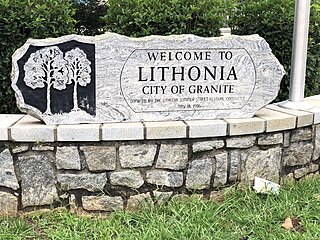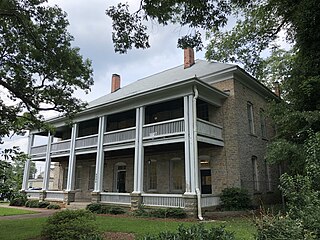Related Research Articles

Rockdale County is a county located in the North Central portion in the U.S. state of Georgia. As of the 2020 census, the population was 93,570 up from 85,215 in 2010. The county seat is Conyers.

DeKalb County is located in the north central portion of the U.S. state of Georgia. As of the 2020 census, the population was 764,382, making it Georgia's fourth-most populous county. Its county seat is Decatur.

Lithonia is a city in eastern DeKalb County, Georgia, United States. The city's population was 2,662 at the 2020 census. Lithonia is in the Atlanta metropolitan area.

Redan is a census-designated place (CDP) in DeKalb County, Georgia, United States. As of the 2020 census, the CDP had a total population of 31,749. It is a predominantly African American community in eastern DeKalb County, and is a suburb of Atlanta.

Stone Mountain is a city in DeKalb County, Georgia, United States. The population was 6,703 according to the 2020 US Census. Stone Mountain is in the eastern part of DeKalb County and is a suburb of Atlanta that encompasses nearly 1.7 square miles. It lies near and touches the western base of the geological formation of the same name. Locals often call the city "Stone Mountain Village" to distinguish it from the larger unincorporated area traditionally considered Stone Mountain and Stone Mountain Park.

Tucker is a city located in DeKalb County, Georgia, United States, located near Atlanta and was originally settled in the 1820s, and later developed as a railroad community in 1892. According to the 2016 United States Census Bureau annual estimate of resident population, it has a population of 35,322. In a November 2015 referendum, by a 3:1 margin (73.94%), voters approved incorporating Tucker into a city. In March 2016, Tucker residents elected the city's first mayor and city council.

Stone Mountain is a quartz monzonite dome monadnock and the site of Stone Mountain Park, 16 miles (26 km) east of Atlanta, Georgia. Outside the park is the small city of Stone Mountain, Georgia. The park is the most visited tourist site in the state of Georgia.
The Atlanta BeltLine is a 22 miles (35 km) open and planned loop of multi-use trail and light rail transit system on a former railway corridor around the core of Atlanta, Georgia. The Atlanta BeltLine is designed to reconnect neighborhoods and communities historically divided and marginalized by infrastructure, improve transportation, add green space, promote redevelopment, create and preserve affordable housing, and showcase arts and culture. The project is in varying stages of development, with several mainline and spur trails complete and others in an unpaved, but hikeable, state. Since the passage of the More MARTA sales tax in 2016, construction of the light rail streetcar system is overseen by MARTA in close partnership with Atlanta BeltLine, Inc.

Arabia Mountain, a part of Arabia Mountain National Heritage Area, is the northern of two peaks in the Davidson-Arabia Mountain Nature Preserve, in DeKalb County, Georgia, United States. A low saddle separates it from Bradley Mountain, several hundred feet to its south. The two form a monadnock. The peak is 955 feet (290 m) above sea level, rising 172 feet (52 m) above Arabia Lake reservoir. Bradley Mountain is closer to the visitor trails than Arabia Mountain and is often misidentified by visitors as Arabia Mountain.
There were several historic mills around the metro Atlanta area, for which many of its current-day roads are still named. Most of the mills date back to the 1820s and 1830s, and were built along the area's many streams. The locations of many of these mills are shown on a map of 1875 showing U. S. military operations around Atlanta in 1864. This map is now located in the U. S. Library of Congress but can be seen on the webpage linked here.
The Atlanta, Stone Mountain and Lithonia Railway (ASM&L) was a rock quarry railroad that began operations in 1909. A "common carrier" railroad it had lines connecting to the Georgia Railroad and primarily served granite and gneiss quarries at Lithonia and at Stone Mountain in DeKalb County. It operated 4 miles of track from Lithonia, Georgia, to a quarry near Rock Chapel, Georgia.
The DeKalb County School District (DCSD) is a school district headquartered at 1701 Mountain Industrial Boulevard in unincorporated DeKalb County, Georgia, United States, near Stone Mountain and in the Atlanta metropolitan area. DCSD operates public schools in areas of DeKalb County that are not within the city limits of Atlanta and Decatur. It will serve a portion of Atlanta annexed by that city in 2018 until 2024, when that portion will be re-assigned to Atlanta Public Schools (APS).

The Mall at Stonecrest is a super regional shopping mall along Interstate 20 in eastern Metro Atlanta that opened in 2001 on the growing I-20 corridor. It is off exit 75 in Stonecrest, Georgia, which became a city in 2017.
The transportation system of Georgia is a cooperation of complex systems of infrastructure comprising over 1,200 miles (1,900 km) of interstates and more than 120 airports and airbases serving a regional population of 59,425 people.
The Autrey Mill Nature Preserve & Heritage Center is located in Johns Creek, Georgia, U.S.A.
Flat Rock is a historic African American community in DeKalb County, Georgia. It is located within the city of Stonecrest, as well as the Arabia Mountain National Heritage Area. Flat Rock is believed to be one of the oldest African American settlements in DeKalb County. In 1820, the area rested along the border of Creek and Cherokee Nation hunting grounds when it was settled during the Georgia Land Lottery. In 1865, after the end of the Civil War, the era of reconstruction provided opportunity for former enslaved people to stay in the area to build schools, churches, and civic organizations and create the tight knit African American Flat Rock Community. The community has continued to live in the area and have experienced the Black Codes, Jim Crow and the Great Migration. The area currently houses the Flat Rock Archives, which specialize in preserving African American rural history in Georgia.

Stonecrest is a city in DeKalb County, Georgia, United States. The boundaries of the city generally lie in the far southeastern corner of the county, and a smaller portion just north of Interstate 20. The city borders the existing municipality of Lithonia, as well as Rockdale and Henry counties.

The Seminary is a historic building at 6886 Main Street in Lithonia, Georgia. Originally constructed as a school in 1895, over the years it has also served as a hotel and a private home. It is currently used as a multi-tenant office building. It was entered into the National Register of Historic Places (NRHP) on November 15, 1978.

The Aaron and Margaret Parker Jr. House is a historic plantation house built c. 1830 that is one of the oldest houses in Rockdale County, Georgia, United States. It is located at 4835 Flat Bridge Road inside the Panola Mountain State Park. It is one and a half stories, constructed in the Plantation Plain style.

The Flat Rock Archives is an African American historical museum located in the city of Stonecrest, Georgia. The mission of the archive is to preserve rural African American history in Georgia. The archive is located in a historic home built by T.A. Bryant, Sr., and was donated in 2005, by Rev. T.A. Bryant, Jr. and his sister, Zudia Guthrie, to preserve and store all the Flat Rock records and documents. It was established as a museum and resource to genealogical and historic research, as well as a heritage tourism site. The Flat Rock Archives consists of a variety of historic sites including the Flat Rock African American Historic Cemetery. All of these sites are located within the Arabia Mountain National Heritage Area. See Flat Rock, Georgia to learn more about the history of this area.
References
- 1 2 "Arabia Mountain PATH - Arabia Mountain National Heritage Area". arabiaalliance.org.
- ↑ "Arabia Mountain PATH – PATH Foundation". pathfoundation.org.
- 1 2 3 "AMP Self-Guided Path Tour" (PDF). arabiaalliance.org. Retrieved 23 April 2023.
- ↑ Roberts, Leigh. Cultural Resources Report for Davidson-Arabia Mountain Nature Preserve. Not published. (1997)
- ↑ Arabia Mountain National Heritage Area Cultural Landscape Assessment: Addendum to the Arabia Mountain Heritage Area Management Plan, 2006
- ↑ "About the Atlanta Region - ARC".
- ↑ "Dairy to Dream - Arabia Mountain National Heritage Area". arabiaalliance.org. 22 January 2015.
- ↑ "Archived copy". Archived from the original on 11 May 2015. Retrieved 21 April 2015.
{{cite web}}: CS1 maint: archived copy as title (link)